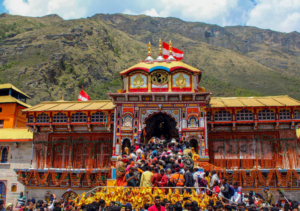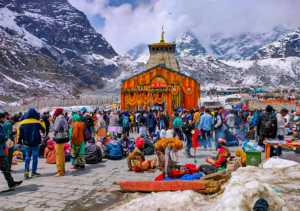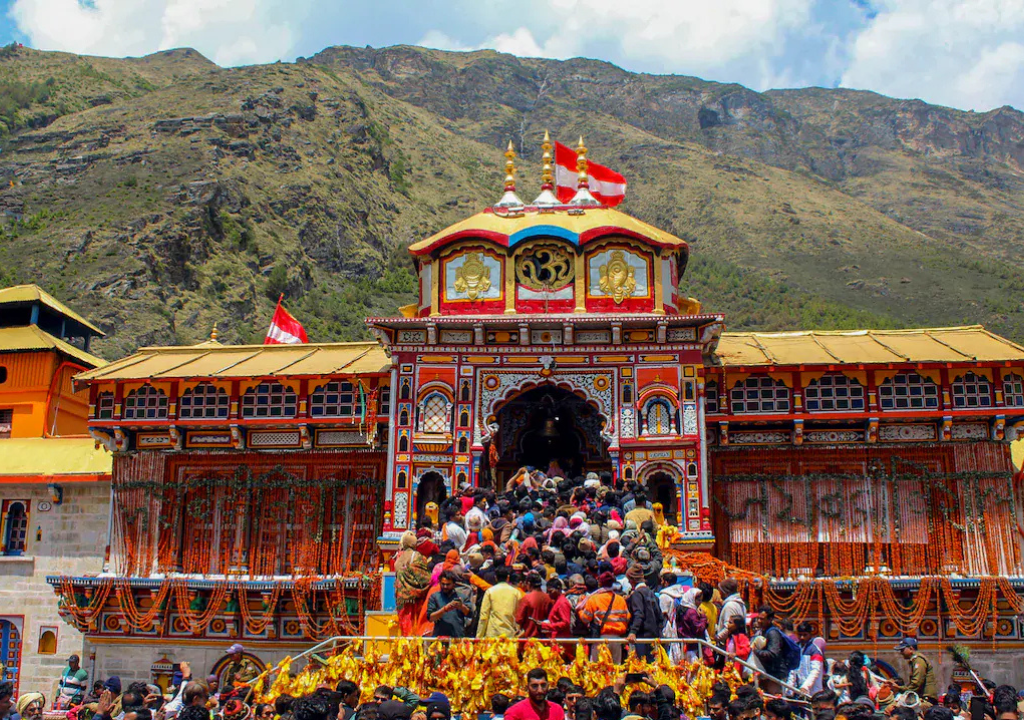As the spiritual Char Dham Yatra season begins, the Badrinath Dham portals opened today May 4, 2025, ushering in a wave of devotion for thousands of Hindu pilgrims. Uttarakhand Chief Minister Pushkar Singh Dhami participated in the auspicious ritual, offering prayers and personally welcoming devotees to the revered shrine. This ceremonial reopening not only marks the formal start of the Char Dham Yatra 2025 but also reaffirms India’s deeply rooted cultural and spiritual traditions. The sacred atmosphere, combined with well-coordinated arrangements, set the tone for a spiritually enriching and safe pilgrimage season.
What Is Badrinath Dham?
Badrinath Dham, nestled in the Garhwal Himalayas of Chamoli district, is one of the four Char Dhams and holds significant spiritual importance for Hindus. It is part of both the Char Dham Yatra and the 108 Divya Desams, making it a central shrine in the Vaishnavite tradition. According to Hindu mythology, Lord Vishnu meditated here for centuries under the Badri tree.
-
Location: Chamoli, Uttarakhand
-
Altitude: 3,300 meters
-
Deity: Lord Badrinarayan (Vishnu)
-
Pilgrimage Season: May to November
-
Founded by: Adi Shankaracharya in the 8th century
Each year, the shrine is closed during the winter months due to heavy snowfall and reopens in summer with a grand ritual. The Badrinath Dham portals opening ceremony is a moment of celebration for millions of devotees.
What Happened on May 4, 2025?
In the early morning hours, the sacred doors of Badrinath Dham were reopened after winter closure. The temple was adorned with fresh flowers and lights as Vedic chants filled the air. CM Pushkar Singh Dhami was present at the ceremony, where he performed rituals alongside temple priests and interacted with visiting devotees.
The Chief Minister emphasized the spiritual and cultural relevance of the occasion. He reviewed the logistical arrangements, including sanitation, crowd control, medical facilities, and digital services for pilgrims. The government has ensured that both infrastructure and the spiritual environment are in sync to make the yatra comfortable and fulfilling.
Importance of Badrinath Dham
Badrinath Dham, one of the 108 Divya Desams and the most important of the Char Dham temples, is located in Chamoli district at an altitude of 3,300 meters. The temple is dedicated to Lord Badrinarayan, a form of Lord Vishnu who is believed to have meditated here.
The temple was established in the 8th century by Adi Shankaracharya, who played a vital role in reviving Hinduism across India. Every year, the shrine is closed during winter and reopens in summer, drawing lakhs of devotees during its open months from May to November.

CM Dhami’s Interaction with Pilgrims
CM Dhami extended a heartfelt welcome to the pilgrims and expressed his commitment to ensuring a safe and spiritually enriching experience for all. He offered prayers for national well-being and spoke to devotees, temple staff, and officials about the arrangements.
He emphasized the role of spiritual tourism in Uttarakhand’s development and highlighted the government’s efforts in:
- Strengthening the connectivity and road networks.
- Ensuring proper sanitation and accommodation facilities.
- Deploying medical teams and rescue personnel in high-risk zones.
- Implementing eco-friendly practices to protect the fragile Himalayan ecosystem.
What Is the Char Dham Yatra?
The Char Dham Yatra is one of the most revered spiritual journeys in India, involving visits to four major temples in Uttarakhand: Yamunotri, Gangotri, Kedarnath, and Badrinath. These shrines are located in the high Himalayan ranges and are collectively known as Char Dham, meaning “four abodes.”
Each of these temples represents an element of the divine:
- Yamunotri: Dedicated to Goddess Yamuna, the source of the Yamuna River.
- Gangotri: Worships Goddess Ganga, the sacred Ganges River’s origin.
- Kedarnath: A Jyotirlinga of Lord Shiva, situated near the Mandakini River.
- Badrinath: Dedicated to Lord Vishnu, seated in meditation at high altitude.
The yatra traditionally starts in the west (Yamunotri) and ends in the east (Badrinath). Pilgrims believe that undertaking this journey washes away sins and opens the path to moksha (liberation).

Char Dham Yatra 2025 Arrangements
This year’s Char Dham Yatra is being conducted under tight government supervision to ensure safety and order. Extensive arrangements have been made in collaboration with central agencies, disaster management authorities, and local organizations.
The key arrangements for 2025 include:
-
Mobile App for Pilgrims: Real-time tracking, health updates, location tagging
-
Registration System: A compulsory online registration system for all pilgrims for crowd control
-
Transport & Helipads: Road repairs, helicopter services for Kedarnath and Badrinath routes.
-
Medical Camps: Medical camps with oxygen cylinders, first-aid, and trauma care units.
-
Security Forces: Deployment of ITBP, SDRF, and state police at key checkpoints
-
Digital Dashboards: Monitor footfall, weather updates, and emergency alerts
The administration is also working with the National Disaster Management Authority (NDMA) to prepare for any unexpected weather or natural calamities.
Links Suggested: Digital India and Cyber Security: Balancing Innovation and Protection
Pilgrim Response and Public Reception
Despite the chilly weather and high-altitude terrain, thousands of pilgrims gathered at Badrinath to witness the auspicious reopening. Their dedication and enthusiasm reflected the undiminished spiritual pull of the dham.
Reports indicate a smooth start to the season with efficient queue management and availability of amenities. Volunteers and spiritual organizations provided free food, water, blankets, and shelter, especially to senior citizens and physically challenged pilgrims.
Many devotees expressed appreciation for the well-coordinated efforts of the temple authorities and local administration.

| Brief Insight
The Economic and Cultural Impact
Beyond religious significance, the Char Dham Yatra plays a crucial role in boosting the local economy of Uttarakhand. It generates seasonal employment in sectors like transportation, hospitality, retail, and religious services. Local artisans, guides, hoteliers, and shopkeepers earn a significant portion of their annual income during this period.
Moreover, the yatra strengthens India’s cultural diplomacy, drawing international visitors and promoting India’s image as a land of ancient wisdom and sacred geography.
Looking Ahead: Spirituality with Sustainability
This year, there’s a renewed push toward combining spirituality with sustainability. The state has undertaken green initiatives to reduce the environmental footprint of mass tourism in the Himalayas.
Long-term goals include:
- Transitioning to solar energy at base camps.
- Promoting e-vehicles and public transport over private ones.
- Strengthening eco-toilets and water conservation systems.
- Educating pilgrims on zero-waste travel practices.
Such steps are essential to preserve the ecology of Uttarakhand and ensure that future generations can continue to access these sacred places without environmental degradation.
Conclusion
The opening of the Badrinath Dham portals marks a momentous start to the Char Dham Yatra 2025, blending tradition with technology, and devotion with duty. Under CM Dhami’s leadership, the event symbolizes not just a religious occasion but a cultural renaissance. As pilgrims undertake their sacred journeys, the state’s proactive governance ensures that faith and functionality go hand-in-hand.
This year’s yatra, enhanced by robust infrastructure, digital tools, and environmental consciousness, could set a national benchmark for religious tourism. The journey to Badrinath and the broader Char Dham circuit continues to inspire millions—both spiritually and socially.
Acknowledgment
Source: ANI News

